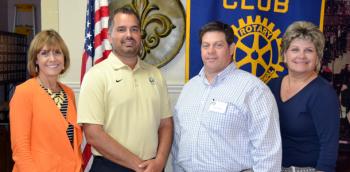
The Rotary Club of Crowley met Tuesday and learned about physical therapy from Rotarian Daryl Albro and were invited to the Crowley High Dinner Auction by guest and CHS football coach Josh Fontenot. Present were, from left, President-Elect M’Elise Trahan, Fontenot, Albro and Secretary Melinda Malmay.
Albro presents 'Evolution of Physical Therapy'
Jeannine LeJeune is the online editor for the Crowley Post-Signal. She can be reached at jeannine.lejeune@crowleytoday.com or 337-783-3450.
In 1914, as the U.S. became involved in World War I, women with a base knowledge set were recruited as reconstruction aides to help with injured veterans.
One hundred years later, those reconstruction aides are now known as physical therapists — and it’s not just for women anymore.
It was during those 100 years, however that the evolution of physical therapy took place, as described Tuesday at the Rotary Club of Crowley’s meeting by Daryl Albro of Crowley Therapy Group, who served not only as program organizer but speaker as well.
Albro took the club on a brief timeline of physical therapy, beginning in 1914-18 and World War I with the reconstruction aides through today.
He also spoke in detail about Mary McMillan, a pioneer in the field.
In the 1920s, the first professional association of physical therapists was formed — the American Women’s Physical Therapeutic Association — led by McMillan, serving as president.
The group included 274 charter members and the following year, the association changed its name to the American Physiotherapy Association.
By the 1930s, the group introduced its first Code of Ethics and men were admitted. Membership grew to just under 1,000.
While physical therapists were brought on first to aid veterans, in the time between the World Wars, physical therapists spent much of their time and efforts on polio patients.
With World War II as well as the polio epidemic, the now American Physical Therapy Association’s membership grew to 8,000 and the number of physical therapy education programs more than doubled (from 16 to 39) in the 1940s and ’50s.
Albro explained, however, that it was in the 1950s that the profession feared for its survival after the wars were ended and the U.S. became eradicated of polio.
Still, the profession of physical therapy did survive and continued to become more and more used. APTA membership reached almost 15,000 and the number of education programs grew to 52 nationwide.
As Albro turned his focus to today, he also helped look forward as APTA has. The APTA has instituted “Vision 2020” as to where the organization wants to see the profession by the year 2020. In that vision, the association would like every physical therapy grad to have a doctorate degree and practice evidence-based medicine.
It also wants therapists to have direct access to patients without the need for a physician’s prescription.
Six years out, the organization has made strides, but is still short of those goals. Albro pointed out that more than 200 programs have been accredited for doctorate programs and that the push for evidence-based medicine continues.
He added that all 50 states have passed laws to help physical therapists have more direct access to patients, but there are some limitations.
Albro also briefly went over the way physical therapists care for their patients and where.
Earlier in the meeting, Crowley High School football coach Josh Fontenot, who was a guest at the Rotary Club meeting, spoke to the club and invited them to the school’s annual Dinner Auction Thursday night. Tickets are on sale now and at the door for $25.
- Log in to post comments
